Metal-passivated PbS nanoparticles: fabrication and characterization
Abstract
Organic-shell-free PbS nanoparticles have been produced in the size range relevant for quantum-dot solar cells (QDSCs) by a vapor aggregation method involving magnetron reactive sputtering. This method creates a beam of free 5–10 nm particles in a vacuum. The dimensions of the particles were estimated after their deposition on a substrate by imaging them using ex situ SEM and HRTEM electron microscopy. The particle structure and chemical composition could be deduced “on the fly”, prior to deposition, using X-ray photoelectron spectroscopy (XPS) with tunable synchrotron radiation. Our XPS results suggest that under certain conditions it is possible to fabricate particles with a semiconductor core and 1 to 2 monolayer shells of metallic lead. For this case the absolute energy of the highest occupied molecular orbital (HOMO) in PbS has been determined to be (5.0 ± 0.5) eV below the vacuum level. For such particles deposited on a substrate HRTEM has confirmed the XPS-based conclusions on the crystalline PbS structure of the semiconductor core. Absorption spectroscopy on the deposited film has given a value of ∼1 eV for the lowest exciton. Together with the valence XPS results this has allowed us to reconstruct the energy level scheme of the particles. The results obtained are discussed in the context of the properties of PbS QDSCs.



 Please wait while we load your content...
Please wait while we load your content...